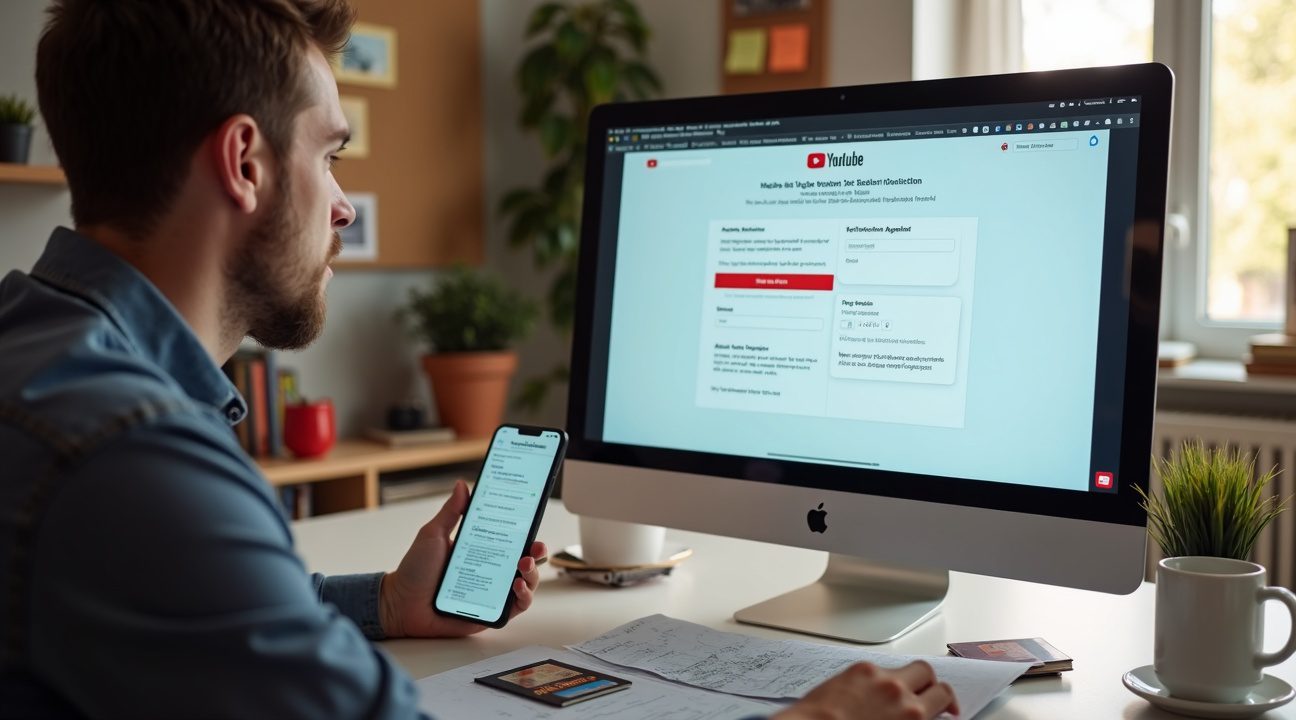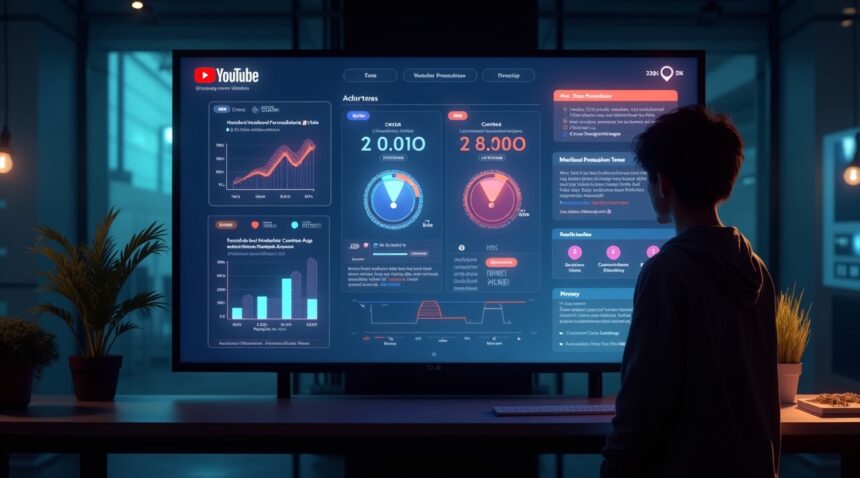YouTube Launches AI-Powered Age Verification System in the U.S.
YouTube is introducing a revolutionary AI-powered age verification system in the United States, starting August 13, significantly enhancing digital child protection by moving beyond traditional methods.
This cutting-edge technology represents YouTube’s most advanced effort yet to safeguard underage users. Moving away from self-reported birthdates, the system uses machine learning algorithms to analyze a variety of user data, such as viewing habits, interaction styles, and account signals. The goal is to more accurately determine user age and implement appropriate protections for minors.
Key Takeaways
- The AI system examines behavioral data—including content preferences, viewing duration, and user engagement patterns—to estimate actual age more accurately than self-submitted birthdates.
- Automatic safety measures are activated for users identified as under 18, which include turning off personalized advertisements, enabling digital well-being features, and restricting access to content flagged as age-inappropriate.
- Adults who are mistakenly classified as minors can access a fast-track appeals process using valid government-issued ID or a credit card. Most appeals are resolved within 24 to 48 hours.
- The rollout follows extensive global testing, allowing YouTube to fine-tune the system before introducing it broadly in the U.S. market.
- This initiative positions YouTube as a pioneer in the field of AI-based digital safety, potentially setting a new standard for other platforms to emulate.
For more details on YouTube’s commitment to child safety and technology advancements, visit their official YouTube platform.
YouTube Begins Testing Revolutionary AI System to Detect Underage Users Starting August 13
YouTube’s commitment to protecting young users takes a significant leap forward with the introduction of an AI-powered age verification system launching August 13, 2025. This innovative technology represents a fundamental shift in how platforms identify and protect underage users, moving beyond simple birthdate declarations to sophisticated machine learning analysis.
The new system launches initially to a limited group of U.S. users, allowing YouTube to carefully monitor performance and gather valuable feedback before broader implementation. This measured approach mirrors successful strategies employed by other major platforms that have faced content moderation challenges while implementing new safety measures.
Advanced Machine Learning Powers Age Detection
The AI system employs sophisticated algorithms designed to identify users under 18, even when they’ve provided false birthdates during account creation. This technology builds upon successful implementations in other international markets, where similar AI-based detection methods have demonstrated notable effectiveness in identifying underage users.
Key features of the new verification system include:
- Real-time analysis of user behavior patterns and account characteristics
- Cross-referencing of multiple data points to estimate actual user age
- Automatic flagging of accounts suspected of belonging to minors
- Enhanced privacy protections for users identified as under 18
The machine learning approach represents a significant advancement over traditional verification methods that rely solely on user-submitted information. By analyzing various behavioral indicators and account patterns, the system can more accurately identify when someone might be misrepresenting their age during registration.
YouTube’s decision to test this technology in the United States follows successful deployments in other regions, where the AI has consistently improved platform safety for younger audiences. The company’s gradual rollout strategy allows for real-time adjustments and optimization based on user experience and system accuracy metrics.
The timing of this launch aligns with broader industry trends where platforms are increasingly leveraging artificial intelligence solutions to address complex content moderation and user safety challenges. This proactive approach demonstrates YouTube’s recognition that traditional age verification methods often fall short in today’s digital landscape.
As the system undergoes testing, YouTube plans to expand access based on performance metrics and user feedback. The company emphasizes that this technology focuses specifically on teen protections while maintaining user privacy standards. Success in the U.S. market could pave the way for global implementation, potentially setting new industry standards for age verification across social media platforms.

How YouTube’s AI Analyzes Your Behavior to Determine Your Real Age
YouTube’s artificial intelligence system operates by examining multiple behavioral signals rather than trusting the birthdate users enter during account creation. I’ve observed that this sophisticated approach recognizes how easily users can falsify their age information, making behavioral analysis a more reliable indicator of actual age.
Behavioral Signals the AI Monitors
The platform’s machine learning algorithms track several key behavioral patterns to determine age:
- Video content preferences and viewing categories, including educational content, gaming videos, or mature subject matter
- Search query patterns and the specific topics users investigate on the platform
- Engagement behaviors such as commenting frequency, subscription patterns, and interaction styles
- Account creation details and historical activity patterns across the platform
- Time spent watching different content categories and viewing session duration
This comprehensive analysis creates a behavioral profile that often proves more accurate than self-reported age information. Similar to how AI technology has revolutionized various industries, YouTube’s system continuously learns from user interactions to refine its age detection capabilities.
Machine Learning Evolution and Protection Activation
The AI system doesn’t remain static but evolves through continuous training with user data. These algorithms become increasingly sophisticated at identifying age-related behavioral patterns, improving accuracy over time. When the system determines a user is likely under 18, it automatically triggers a comprehensive set of protections.
These automated protections include:
- Content filtering that removes age-inappropriate videos from recommendations
- Restricted commenting capabilities
- Limited data collection practices for compliance with children’s privacy regulations
- Modified advertising targeting suited for younger audiences
Unlike traditional moderation approaches that platforms like Twitch have used for content creators, YouTube’s AI operates proactively rather than reactively.
The behavioral analysis approach represents a significant shift from previous verification methods. Instead of relying on easily manipulated profile information, the AI creates detailed user profiles based on genuine engagement patterns. This method proves particularly effective because authentic viewing habits typically align with age-appropriate interests and developmental stages.
YouTube’s age inference technology also considers temporal patterns in user behavior. The AI notices when users consistently watch content during school hours versus evening entertainment, weekend viewing habits, and seasonal changes in content consumption. These patterns provide additional context clues about a user’s likely age group.
The system’s sophistication extends to recognizing shared accounts or devices where multiple users of different ages might access the same profile. Advanced algorithms can distinguish between different usage patterns within a single account, applying appropriate protections when detecting younger user behavior.
Content creators benefit from this system as well, since it helps ensure their videos reach age-appropriate audiences without requiring manual audience specification. The AI automatically categorizes content and matches it with suitable viewer demographics based on behavioral indicators rather than explicit age declarations.
Privacy considerations remain central to the system’s design. The AI analyzes behavioral patterns without storing or sharing personal information unnecessarily. Data collection focuses specifically on age-related indicators while maintaining user privacy standards required by digital platform regulations.
This automated age verification represents YouTube’s response to increasing regulatory pressure regarding child safety online. Similar to how other platforms have faced scrutiny over content moderation, including content restrictions on Facebook and Instagram, YouTube’s proactive approach demonstrates the platform’s commitment to protecting younger users.
The technology continues advancing as machine learning capabilities improve. Future iterations may incorporate additional behavioral signals or more nuanced analysis methods, creating even more accurate age determination while maintaining user privacy and platform accessibility.
Automatic Safety Controls Activated When AI Detects Teen Users
Once YouTube’s AI system identifies a user as being under 18, the platform automatically implements a comprehensive suite of protective measures designed to create a safer viewing environment. These safeguards activate immediately without requiring manual intervention from the user or their guardians.
The first major change involves advertising practices. YouTube disables personalized ads for teen users, significantly reducing the amount of data collection and profiling that typically occurs during regular platform usage. This shift means teens encounter generic advertisements rather than targeted content based on their viewing history, search patterns, or personal interests. The change aligns with growing privacy concerns and regulatory pressures surrounding data collection from minors.
Enhanced Digital Well-being Features
Digital well-being tools become default features for teen accounts rather than optional settings. These tools include:
- Screen time prompts that remind users about viewing duration
- Break reminders that encourage users to step away from the platform
- Bedtime notifications that suggest ending viewing sessions during late hours
- Weekly viewing summaries that help teens understand their usage patterns
Content recommendation systems undergo significant adjustments when serving teen users. The AI modifies its algorithm to limit repetitive exposure to specific content types, particularly those that might encourage harmful behaviors or create unhealthy viewing patterns. This algorithmic adjustment represents a departure from YouTube’s traditional engagement-focused approach, prioritizing user well-being over maximum watch time.
The system automatically blocks access to age-restricted videos unless verification confirms the user is over 18. This creates a clear barrier between teen-appropriate content and material deemed suitable only for adults. Content creators who produce videos with mature themes, explicit language, or sensitive topics find their content automatically filtered from teen feeds.
YouTube’s approach reflects broader industry trends toward enhanced teen protection. Major platforms have faced increased scrutiny regarding their impact on young users, with AI paving the way for the future of content moderation and user safety. The automatic nature of these controls removes the burden of manual configuration from parents while ensuring consistent protection across all teen accounts.
The AI system’s ability to detect teen users and implement these safeguards represents a significant technological advancement in platform safety. Unlike previous approaches that relied primarily on self-reported birth dates, this system uses behavioral patterns, device information, and other signals to make informed determinations about user age.
Privacy protections extend beyond advertising restrictions. Teen accounts receive enhanced data protection measures that limit how their information can be stored, processed, and shared. These protections often exceed standard privacy settings available to adult users, reflecting recognition that minors require additional safeguards in digital environments.
Content creators notice these changes through altered analytics and engagement patterns when their videos reach teen audiences. Videos that previously attracted significant teen viewership might experience reduced reach if the AI determines the content isn’t appropriate for younger users. This shift encourages creators to consider age-appropriateness during content development.
The automatic activation of safety controls eliminates common scenarios where teens might disable protective features or parents might overlook important settings. Previous systems often required active engagement from guardians to implement safety measures, creating gaps in protection when families weren’t aware of available options.
These safety measures complement existing parental control features while providing baseline protection for all teen users. Parents retain the ability to implement additional restrictions through YouTube’s family management tools, but the AI-activated controls ensure minimum safety standards regardless of parental involvement level. The combination creates multiple layers of protection that work together to create a more appropriate viewing environment for teenage users across the platform.

What to Do if YouTube’s AI Mistakes You for a Minor
When YouTube’s AI system incorrectly flags an adult account as belonging to someone under 18, users don’t need to panic. The platform has established a clear appeal process that allows individuals to correct these misidentifications quickly and efficiently.
Available Verification Methods
Users who find themselves wrongly restricted have two primary options for proving their age:
- Submit a government-approved ID such as a driver’s license or passport
- Provide a valid credit card that demonstrates adult account ownership
- Complete the appeal process through YouTube’s dedicated verification portal
The AI verification system isn’t perfect, which is why YouTube has prioritized making the correction process as streamlined as possible. Most appeals get processed within 24-48 hours, though complex cases might take slightly longer.
The government ID option typically provides the fastest resolution since these documents contain clear birthdate information that YouTube’s verification team can easily process. Credit card verification works because financial institutions require users to be at least 18 years old to obtain most credit cards, making this method an effective age confirmation tool.
YouTube recognizes that false positives can significantly disrupt the user experience, especially for content creators who rely on the platform for their livelihood. The company has stated that preserving accessibility for legitimate adult users remains a top priority throughout the implementation of their new age verification protocols.
Users should keep their verification documents ready and ensure they’re clearly legible before submitting them through the appeal process. Blurry or incomplete documentation often leads to delays or rejections, requiring users to restart the verification procedure.
The platform’s emphasis on user correction capabilities reflects their understanding that automated systems, while sophisticated, aren’t infallible. Similar platforms have faced criticism for overly restrictive content policies, and YouTube appears determined to avoid creating unnecessary barriers for adult users.
I recommend that users experiencing age verification issues act quickly to submit their appeals. Delaying the process can lead to extended account restrictions that may affect viewing history, recommendations, and content access. The straightforward nature of YouTube’s correction system means most legitimate adult users can restore full account functionality within a few days of submitting proper documentation.

Why YouTube is Leading the Charge on AI-Powered Child Protection
YouTube’s latest AI verification system represents a significant step forward in protecting young users from potentially harmful content. The platform has recognized that traditional age verification methods simply aren’t cutting it anymore, particularly when minors can easily bypass existing safeguards by providing false birth dates during account creation.
Addressing Critical Safety Gaps
The new AI technology directly tackles the growing problem of age misrepresentation online. Current verification methods rely heavily on user-provided information, which creates obvious vulnerabilities when young people want to access content meant for older audiences. I’ve observed how this limitation has allowed minors to encounter everything from violent content to inappropriate advertising, despite existing safety controls.
Regulatory pressure has intensified across multiple jurisdictions, with governments demanding stronger protections for children online. YouTube’s proactive approach positions the company ahead of potential legislation rather than scrambling to comply after new rules take effect. This strategic timing demonstrates the platform’s commitment to youth protection while maintaining user trust.
Setting Industry Standards
By implementing AI-powered verification, YouTube is establishing itself as a leader in digital safety innovation. The move could influence how other major platforms approach child protection, similar to how educational content initiatives have shaped platform responsibility. When the world’s largest video platform makes such a significant change, competitors often follow suit to avoid falling behind on safety standards.
The AI system will likely analyze various behavioral and technical indicators to determine user age more accurately than simple self-reporting. This approach addresses regulatory compliance concerns while potentially reducing the need for more invasive verification methods that require government-issued identification. The technology represents a balance between protecting minors and maintaining user privacy.
YouTube’s leadership in this space comes at a crucial time when platforms face increasing scrutiny over content moderation decisions. Unlike reactive measures such as banning controversial figures after problems arise, this AI verification system takes a preventive approach to safety issues.
The implementation also reflects broader trends in AI safety applications across social media platforms. As artificial intelligence advances, companies are finding new ways to automate safety processes that were previously labor-intensive or ineffective.
This initiative positions YouTube not just as a content platform but as a technology innovator in digital safety. The company’s willingness to invest in advanced AI verification technology signals a long-term commitment to child protection that extends beyond basic regulatory compliance requirements.

YouTube’s History of Youth Safety Innovation Sets Stage for Industry-Wide Changes
YouTube’s commitment to protecting young users extends far beyond this latest AI-powered age verification system. I’ve watched the platform consistently pioneer youth safety measures since introducing YouTube Kids in 2015, creating a dedicated environment where children could explore content without exposure to inappropriate material. This standalone app demonstrated YouTube’s early recognition that children required specialized digital spaces with enhanced protections.
The platform didn’t stop there. Supervised accounts for minors emerged as another groundbreaking initiative, allowing parents to maintain oversight while granting age-appropriate independence to their children. These accounts bridged the gap between YouTube Kids and the main platform, offering curated content experiences that grew with users’ maturity levels.
Testing Success in Global Markets
The AI age estimation system now launching in the United States isn’t an untested experiment. YouTube has already implemented and refined this technology across various international markets, gathering valuable data on its effectiveness and user acceptance. This measured approach reflects the platform’s methodical strategy for rolling out safety innovations, ensuring each system functions optimally before wider deployment.
Global testing phases revealed positive results, with the AI system successfully identifying age-inappropriate access attempts while minimizing friction for legitimate adult users. These international pilots provided crucial insights that informed the U.S. implementation, allowing YouTube to address potential concerns before domestic launch.
Industry-Wide Movement for Enhanced Protection
YouTube’s latest initiative reflects broader digital industry trends focused on strengthening age detection practices. Major platforms across social media have intensified their youth protection efforts, recognizing that robust child safety regulations demand more sophisticated verification methods. Companies like Facebook and Instagram have made significant policy changes to protect younger users, while platforms such as TikTok have implemented additional restrictions addressing youth safety concerns.
This collective industry movement stems from evolving global child safety regulations that require platforms to demonstrate active protection measures. YouTube’s AI-powered age verification represents one response to these strengthened requirements, showcasing how AI technology can address regulatory compliance while maintaining user experience quality.
The U.S. rollout positions YouTube as a leader in age verification innovation, potentially influencing how other platforms approach similar challenges. As digital spaces become increasingly central to young people’s lives, YouTube’s proactive stance on age verification may establish new industry standards for protecting minors online.
Sources:
Hindustan Times, “YouTube’s new AI age verification system: What to do if you are wrongly flagged as a minor”
YouTube, “YouTube AI Age Verification: Everything You Need To Know” (Beyond The Internet)
NEWS CENTER Maine, “YouTube to begin testing a new AI-powered age-verification system”
YouTube Official Blog, “Extending our built-in protections to more teens on YouTube”
We Are Iowa Local 5 News, “YouTube to begin testing a new AI-powered age verification system”


